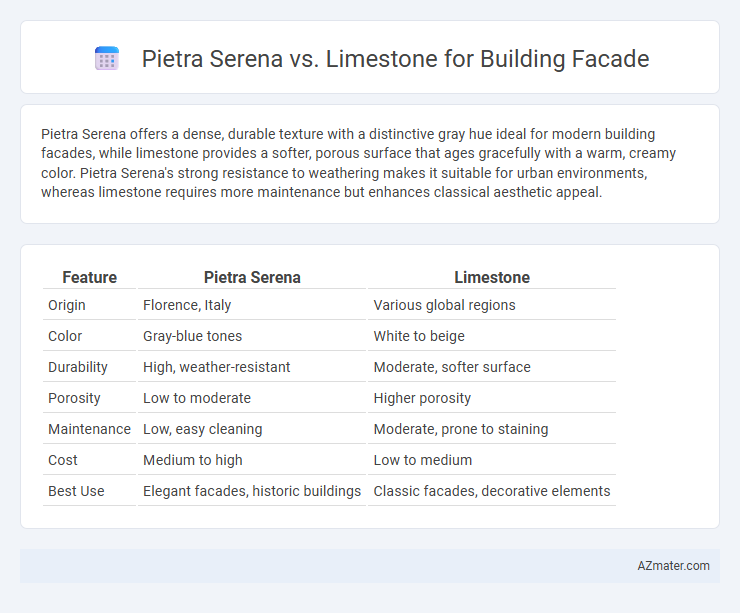Pietra Serena offers a dense, durable texture with a distinctive gray hue ideal for modern building facades, while limestone provides a softer, porous surface that ages gracefully with a warm, creamy color. Pietra Serena's strong resistance to weathering makes it suitable for urban environments, whereas limestone requires more maintenance but enhances classical aesthetic appeal.
Table of Comparison
| Feature | Pietra Serena | Limestone |
|---|---|---|
| Origin | Florence, Italy | Various global regions |
| Color | Gray-blue tones | White to beige |
| Durability | High, weather-resistant | Moderate, softer surface |
| Porosity | Low to moderate | Higher porosity |
| Maintenance | Low, easy cleaning | Moderate, prone to staining |
| Cost | Medium to high | Low to medium |
| Best Use | Elegant facades, historic buildings | Classic facades, decorative elements |
Introduction to Building Facade Materials
Pietra Serena and limestone are prominent natural stones used in building facades, each offering unique aesthetic and structural qualities. Pietra Serena, known for its smooth texture and deep gray-blue color, provides durability and a modern yet classic appearance ideal for contemporary architecture. Limestone features a lighter, often beige or creamy hue with a softer texture, favored for its versatility and timeless elegance in both traditional and modern facade designs.
What is Pietra Serena?
Pietra Serena is a fine-grained, blue-gray sandstone quarried mainly in Tuscany, Italy, prized for its durability and aesthetic appeal in architectural facades. Unlike traditional limestone, Pietra Serena offers a distinctive color palette and superior resistance to weathering and pollution, making it ideal for both restoration and contemporary construction. Its natural veining and smooth texture provide a timeless elegance that enhances the visual impact of building exteriors.
Overview of Limestone as a Facade Material
Limestone is a sedimentary rock widely valued for its durability and aesthetic appeal in building facades, offering a range of colors from creamy white to earthy tones. Its fine-grained texture provides a smooth finish that withstands weathering, making it ideal for both modern and classical architectural styles. Limestone's natural thermal insulation properties and ease of carving enable versatile design options while maintaining structural integrity over time.
Aesthetic Differences Between Pietra Serena and Limestone
Pietra Serena offers a smooth, gray-blue hue with subtle veining that provides a modern, elegant aesthetic for building facades, contrasting with limestone's warmer tones ranging from creamy white to soft beige, which evoke a classic, timeless appearance. The fine-grained texture of Pietra Serena enhances sleek architectural lines, while limestone's porous and varied surface creates a more rustic and natural look. These distinct visual characteristics influence design choices, with Pietra Serena favored in contemporary urban settings and limestone preferred for traditional, historic, or Mediterranean-inspired facades.
Durability and Weather Resistance Comparison
Pietra Serena, a dense volcanic stone from Italy, offers superior durability and weather resistance compared to typical limestone due to its tighter grain structure and lower porosity, reducing water absorption and freeze-thaw damage. Limestone, often softer and more porous, is prone to erosion and acid rain degradation, making it less suitable for harsh climates or urban environments with high pollution levels. Both materials are used in historic and modern facades, but Pietra Serena's enhanced resilience ensures longer-lasting structural integrity and lower maintenance costs in weather-exposed applications.
Sustainability and Environmental Impact
Pietra Serena offers a sustainable option for building facades due to its natural durability and low maintenance requirements, reducing long-term environmental impact. Limestone, while also natural, often demands more energy-intensive quarrying and processing, leading to higher carbon emissions and resource depletion. Both materials are recyclable, but Pietra Serena's regional availability can lower transportation emissions, enhancing its eco-friendly profile.
Cost Analysis: Pietra Serena vs Limestone
Pietra Serena generally costs more than standard limestone due to its rarity and regional sourcing primarily from Tuscany, Italy, whereas limestone is widely quarried globally, making it more affordable and accessible. Installation expenses for Pietra Serena tend to be higher because of its density and specialized craftsmanship required to handle the stone's unique characteristics. Maintenance costs for both materials are comparable, but limestone may require more frequent sealing to prevent weathering, impacting long-term expenses.
Common Architectural Applications
Pietra Serena is a fine-grained sandstone favored for its durability and smooth texture, commonly used in classical and Renaissance architectural facades for detailed sculptural elements and cladding. Limestone, with its varied porosity and color ranging from creamy white to warm beige, is widely employed in historic and contemporary facades, providing excellent weather resistance and ease of carving for ornamental features. Both materials offer natural aesthetics and structural functionality, but Pietra Serena is preferred for precision in intricate designs, while limestone excels in broader surface applications and thermal insulation.
Maintenance Requirements for Each Stone
Pietra Serena requires minimal maintenance due to its dense, fine-grained texture, which resists staining and weathering, making it suitable for building facades with prolonged durability. Limestone, being more porous and softer, demands regular sealing and cleaning to prevent erosion, discoloration, and damage from environmental pollutants. Proper maintenance schedules for limestone involve frequent inspections and treatments, whereas Pietra Serena's robustness reduces upkeep frequency, lowering long-term maintenance costs.
Conclusion: Which Stone Suits Your Project Best?
Pietra Serena offers a sleek, uniform gray appearance with strong durability, ideal for modern, minimalist facades requiring a smooth finish. Limestone provides versatile color variations and a softer texture, lending itself well to classic or ornate architectural styles but may require more maintenance due to its porous nature. Choosing between Pietra Serena and Limestone depends on the desired aesthetic, environmental exposure, and long-term durability needs of your building facade.

Infographic: Pietra Serena vs Limestone for Building Facade
 azmater.com
azmater.com